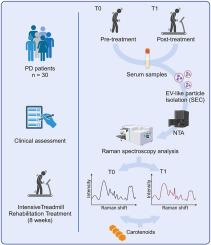循环颗粒类胡萝卜素与帕金森病的康复恢复有关
IF 11.9
1区 生物学
Q1 BIOCHEMISTRY & MOLECULAR BIOLOGY
引用次数: 0
摘要
循环纳米颗粒包括细胞外囊泡(ev)和其他循环ev样颗粒,它们是已知的转运与帕金森病(PD)进展相关的病理蛋白的介质,也是该疾病特征的氧化损伤产物的介质。在VIRTREAD-PD试验方案的框架下,从30名PD患者在使用跑步机进行强化康复计划前后的血清中分离循环颗粒。拉曼光谱用于验证循环颗粒生物化学的变化,并证明强化运动康复计划可以影响PD患者血液中ev样颗粒的分子组成。在8周强化康复前后进行的分析表明,与ev样颗粒相关的生物分子和类胡萝卜素含量发生了显著变化。与循环颗粒相关的抗氧化剂的存在被证明对入院时pwPD的分析和康复恢复的预后具有重要意义。本文章由计算机程序翻译,如有差异,请以英文原文为准。

Circulating particles carotenoids are associated with rehabilitation recovery in Parkinson's disease
Circulating nanoparticles include Extracellular Vesicles (EVs) and other circulating EV-like particles that are known mediators of the trafficking of pathologic proteins associated with Parkinson's disease (PD) progression as well as of products of the oxidative damage that characterizes the disease. In the framework of the VIRTREAD-PD trial protocol, circulating particles were isolated from the serum of 30 subjects with PD before and after an intensive rehabilitation program using a treadmill. Raman spectroscopy was used to verify modifications in the biochemistry of circulating particles and proved that an intensive motor rehabilitation program could affect the molecular composition of EV-like particles in the blood of people with PD (pwPD). Analysis performed before and after 8 weeks of intensive rehabilitation demonstrate significant changes in the biomolecules associated with EV-like particles and in carotenoid content. The presence of antioxidants linked to circulating particles was proved to be informative for the profiling of pwPD at admission and prognostic of the rehabilitation recovery.
In conclusion, our data support the hypothesis that circulating particles have a dual role in PD, both in the neurodegenerative processes and in the response to rehabilitation. Besides, the Raman fingerprint and the spectral signature of carotenoids can represent measurable biomarkers of rehabilitation.
求助全文
通过发布文献求助,成功后即可免费获取论文全文。
去求助
来源期刊

Redox Biology
BIOCHEMISTRY & MOLECULAR BIOLOGY-
CiteScore
19.90
自引率
3.50%
发文量
318
审稿时长
25 days
期刊介绍:
Redox Biology is the official journal of the Society for Redox Biology and Medicine and the Society for Free Radical Research-Europe. It is also affiliated with the International Society for Free Radical Research (SFRRI). This journal serves as a platform for publishing pioneering research, innovative methods, and comprehensive review articles in the field of redox biology, encompassing both health and disease.
Redox Biology welcomes various forms of contributions, including research articles (short or full communications), methods, mini-reviews, and commentaries. Through its diverse range of published content, Redox Biology aims to foster advancements and insights in the understanding of redox biology and its implications.
 求助内容:
求助内容: 应助结果提醒方式:
应助结果提醒方式:


